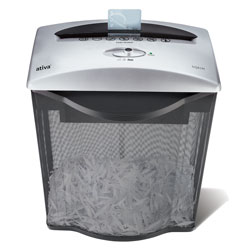Paper shredder
From DDL Wiki
(→Product Dissection) |
(→Functional Operation:) |
||
| Line 6: | Line 6: | ||
The following notes were taken prior to and during [[product dissection]]. | The following notes were taken prior to and during [[product dissection]]. | ||
===Functional Operation:=== | ===Functional Operation:=== | ||
| - | There is an off/auto/reverse switch that allows power to go to the shredder. When it is on auto, the paper being put into the shredder presses an air damper which presses a switch and sends power to the AC motor. The damper slowly depresses and when it is fully depressed the switch is released. The AC motor drives a gear train that reduces the speed of the shaft rotation and increases the torque. The first two gears are helical gears in order to reduce noise. At the end of the gear train, two spur gears are meshed and attached to individual shafts with cross-hatching blades. The blades spin in opposite directions and the paper is fed in between the spinning blades. Shredded paper falls into basket. | + | There is an off/auto/reverse switch that allows power to go to the shredder. When it is on auto, the paper being put into the shredder presses an air damper which presses a switch and sends power to the AC motor. The damper slowly depresses and when it is fully depressed the switch is released. The AC motor drives a gear train that reduces the speed of the shaft rotation and increases the torque. The first two gears are helical gears in order to reduce noise. At the end of the gear train, two spur gears are meshed and attached to individual shafts with cross-hatching blades. The blades spin in opposite directions and the paper is fed in between the spinning blades. The blades are in a wave shape that cuts paper into the desired diamond shaped shreds. Shredded paper falls into basket. |
==Function/Purpose:== | ==Function/Purpose:== | ||
Revision as of 15:47, 27 January 2007

Contents |
Product Study
Product Dissection
The following notes were taken prior to and during product dissection.
Functional Operation:
There is an off/auto/reverse switch that allows power to go to the shredder. When it is on auto, the paper being put into the shredder presses an air damper which presses a switch and sends power to the AC motor. The damper slowly depresses and when it is fully depressed the switch is released. The AC motor drives a gear train that reduces the speed of the shaft rotation and increases the torque. The first two gears are helical gears in order to reduce noise. At the end of the gear train, two spur gears are meshed and attached to individual shafts with cross-hatching blades. The blades spin in opposite directions and the paper is fed in between the spinning blades. The blades are in a wave shape that cuts paper into the desired diamond shaped shreds. Shredded paper falls into basket.
Function/Purpose:
Shreds paper or credit cards placed correctly into feeder
- Increase security – not able to easily retrieve information from shredded items
- Facilitate disposal – reduce volume of garbage
- Produce confetti
- Substitute for a recycling bin
Inputs/Outputs:
- Material Inputs: Paper, Staples, Credit Cards
- Information Inputs: Direction of motor rotation
- Energy Inputs: 120V AC
- Material Outputs: Shredded material inputs
- Information Outputs: Operation status
- Energy Outputs: Heat, Noise, Light
Use:
1. Scale moved to where weighing takes place (ground) - NOTE: Shaking – noise made
2. Observed zero reading of dial (does it need calibrating)
3. Calibration – locate calibration dial, turn dial until zero lines up with red line
4. Steping on the scale
- Orientation of the feet around the dial window
- Even distribution of weight
- One foot first, then the full weight
5. Wait for dial to reach equilibrium
6. Read the number that lines up with the red line
Different Users / Use Scenarios
- Weighing objects
- Balance difficult in stepping
- Weight beyond capacity
- Body shape in the line of vision
- Different eyesight
- Lighting
- Flat surface
- Calibration tasks, difficult for Parkinsons, limited hand-eye coordination
Functional Operation:
1. Force applied to cover
2. Angle brackets transfer force to levers
3. Levers amplify the force and transfer to the spring plate
4. Spring compresses proportionally to the force applied
5. Pivot transfers vertical motion of the spring plate to the horizontal motion of the rack (amplifies as well)
6. Rack and pinion translates linear motion into rotational motion
7. Rotational motion is read out on the dial
| Part # | Part name | QTY | Function |
|---|---|---|---|
| 001 | Angle bracket | 4 |
|
| 002 | Cover plate | 1 |
|
| 003 | Lower lever | 2 |
|

